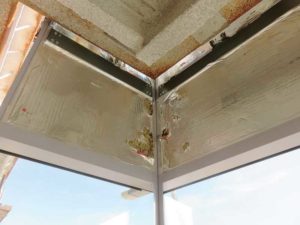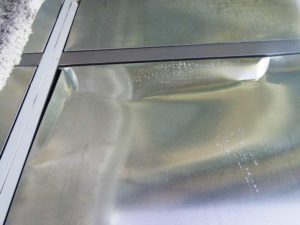Rigid Continuous at Spandrel Glass





 FAILURES
FAILURES
Deborah Slaton, David S. Patterson, AIA, and Jeffrey N. Sutterlin, PE
Unitized curtain wall systems offer many benefits when used for the building enclosure. They can increase quality control of the overall system, as the units are largely shop-fabricated under controlled conditions rather than field-assembled. Further, the relatively large units mean quicker installation than stick-built systems that require installation of individual components in the field; this allows interior fit-out to start earlier.
Since unitized curtain walls rely largely on internal gaskets to control air infiltration and water penetration into the building, they minimize use of exterior sealant that would require future maintenance. Also, since cranes or window manipulators are employed for installation, there is typically no need for exterior access during erection.

Photos courtesy Wiss, Janney, Elstner Associates
Despite the benefits of these systems, however, they are not without their vulnerabilities. Semi-rigid mineral wool is often used to insulate spandrel and other non-vision areas; the insulation is installed with either a reinforced aluminum foil facer or sheet metal backpan on its inboard surface to create an interior air and vapor barrier. Foil-faced mineral wool is typically secured to perimeter framing members with reinforced aluminum tape to provide barrier continuity, while sheet metal backpans are typically continuously sealed to perimeter framing members with an elastomeric sealant. As noted in the Glass Association of North America's GANA Glazing Manual, it is important to maintain a complete air/vapor barrier on the warm (interior) side of this assembly to reduce the potential for condensation on the inboard surface of the spandrel glass (or metal panel).
Unitized curtain wall assemblies are usually delivered to the project site with the foil-faced spandrel insulation or insulated backpans already installed. Therefore, the rather fragile foil facing (or more robust sheet metal) could be damaged during transportation, handling, and erection. If these barriers are damaged and the wall is exposed to rainfall during construction, water can migrate into the assembly and become trapped within, wetting the insulation. Breaches in the barrier can also provide pathways for moisture-laden interior air to migrate into the panels once the building is in service.

Left unaddressed, moisture within the insulation (or spandrel) can result in future condensation issues and/or premature failure of opacifiers used to obscure the glass. As such, damage to foil facers and sheet metal backpans should be repaired as soon as it is noticed during construction, following confirmation the insulation is dry so as to avoid trapping moisture within.
The opinions expressed in Failures are based on the authors' experiences and do not necessarily reflect those of the CSI or The Construction Specifier.
Deborah Slaton is an architectural conservator and principal with Wiss, Janney, Elstner Associates (WJE) in Northbrook, Illinois, specializing in historic preservation and materials conservation. She can be reached at dslaton@wje.com.
David S. Patterson, AIA, is an architect and senior principal with the Princeton, New Jersey, office of WJE, specializing in investigation and repair of the building envelope. He can be contacted at dpatterson@wje.com.
Jeffrey N. Sutterlin, PE, is an architectural engineer and senior associate with WJE's Princeton office, specializing in investigation and repair of the building envelope. He can be reached at jsutterlin@wje.com.


Source: https://www.constructionspecifier.com/keeping-unitized-curtain-walls-dry/
0 Response to "Rigid Continuous at Spandrel Glass"
Enregistrer un commentaire